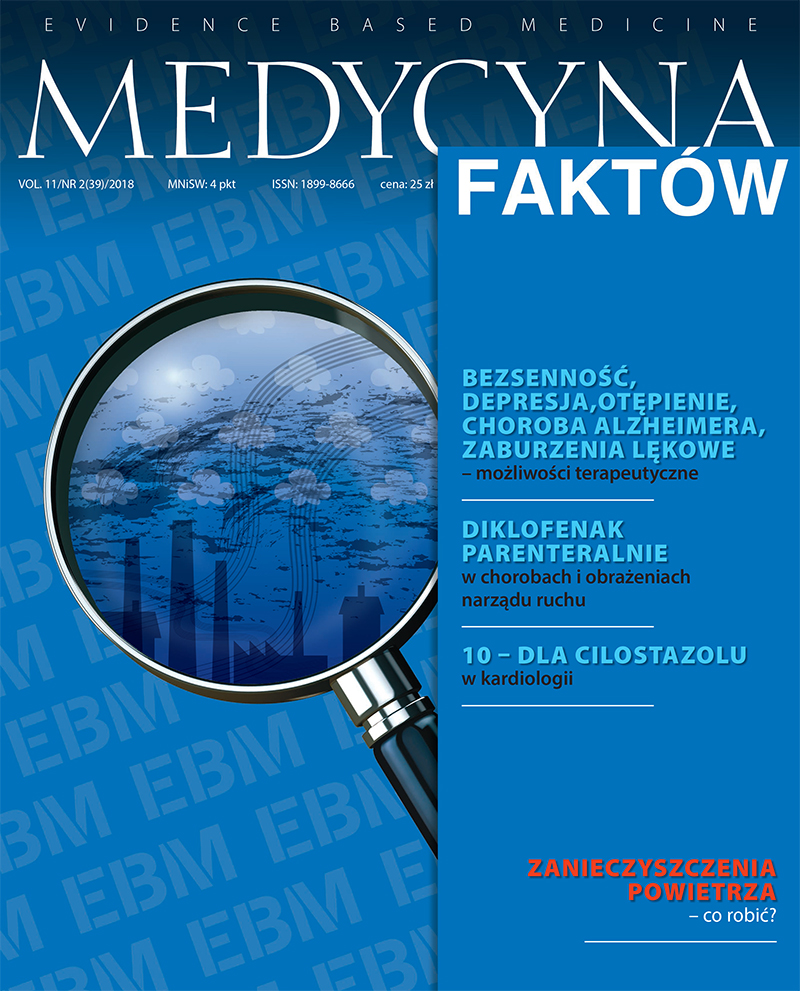Zanieczyszczenia powietrza – co można zrobić? Artykuł przeglądowy
##plugins.themes.bootstrap3.article.main##
Abstrakt
Zanieczyszczenie powietrza stanowi jedną z głównych przyczyn zgonów na świecie, a najbardziej podatne na jego szkodliwe działanie są osoby starsze oraz pacjenci z chorobami układu oddechowego i sercowo-naczyniowego. W Polsce stężenia zanieczyszczeń są jednymi z najwyższych w Unii Europejskiej, a wiedza społeczeństwa o źródłach i wpływie zanieczyszczeń na zdrowie jest bardzo niska. Istotną rolę w informowaniu o zanieczyszczeniu powietrza, jego skutkach zdrowotnych i sposobach ochrony powinni odgrywać lekarze, przekazując krótkie, dostosowane do danej osoby komunikaty. Pacjenci mogą podjąć szereg działań zmniejszających wpływ zanieczyszczeń na ich zdrowie, m.in.: dostosowanie wychodzenia na zewnątrz do aktualnego poziomu zanieczyszczeń, korzystanie z domowych filtrów powietrza HEPA oraz poruszanie się w oddaleniu od głównych dróg. Ważne jest, by pacjenci wiedzieli, gdzie znaleźć rzetelne informacje o aktualnych poziomach zanieczyszczeń oraz jakie działania mogą podjąć.
##plugins.themes.bootstrap3.article.details##
Copyright © by Medical Education. All rights reserved.
Bibliografia
2. Landrigan P.J., Fuller R., Acosta N.J.R. et al.: The Lancet Commission on pollution and health. Lancet 2018; 391(10119): 462-512.
3. GBD 2015 Risk Factors Collaborators: Global, regional, and national comparative risk assessment of 79 behavioural, environmental and occupational, and metabolic risks or clusters of risks, 1990-2015: a systematic analysis for the Global Burden of Disease Study 2015. Lancet 2016; 388(10053): 1659-1724.
4. Mead M.N.: Who’s at risk? Gauging susceptibility to air pollutants. Environ. Health Perspect. 2011; 119(4): A176.
5. Tworzymy atmosferę, M.o.t. Environment. Editor, Warszawa 2015.
6. Wantuch D.: Diesle bez filtrów won z Polski. Rząd ma rekomendacje, by karać kierowców i diagnostów za brak filtrów cząstek stałych. Gazeta Wyborcza, Warszawa 2018.
7. Alert K.S.: What do we know about smog? Informing about air pollution in Poland. Warszawa 2015.
8. WHO: WHO Global Urban Ambient Air Pollution Database. World Health Organization 2016.
9. Myllyvirta L.: Silent Killers – Why Europe must replace coal power with green energy. Amsterdam 2013.
10. Ya-Hong W., Zi-Ying L., La-Wei Y. et al.: PM 2.5 exacerbate allergic asthma involved in autophagy signaling pathway in mice. Int. J. Clin. Exp. Pathol. 2016; 9(12): 12247-12261.
11. GBD 2016 DALYs and HALE Collaborators: Global, regional, and national disability-adjusted life-years (DALYs) for 333 diseases and injuries and healthy life expectancy (HALE) for 195 countries and territories, 1990-2016: a systematic analysis for the Global Burden of Disease Study 2016. Lancet 2017; 390(10100): 1260-1344.
12. Laumbach R., Meng Q., Kipen H.: What can individuals do to reduce personal health risks from air pollution? J. Thorac. Dis. 2015; 7(1): 96-107.
13. Powell P., Brunekreef B., Grigg J.: How do you explain the risk of air pollution to your patients? Breathe 2016; 12(3): 201-203.
14. Aziz A., Bajwa I.U.: Erroneous mass transit system and its tended relationship with motor vehicular air pollution (An integrated approach for reduction of urban air pollution in Lahore). Environ. Monit. Assess 2008; 137(1-3): 25-33.
15. Krewski D., Rainham D.: Ambient air pollution and population health: overview. J. Toxicol. Environ. Health A. 2007; 70(3-4): 275-283.
16. Oltra C., Sala R.: Perception of risk from air pollution and reported behaviors: a cross-sectional survey study in four cities. J. Risk Res. 2016: 1-16.
17. Protection, C.I.f.E.: Annual Report on the Quality of Air in the Masovian Voivodeship for 2007. Warszawa 2007.
18. Protection, C.I.o.E.: Annual Report on the Quality of Air in the Masovian Voivodeship for 2016. Warszawa 2016.
19. Jones N.C., Thornton C., Mark D., Harrison R.: Indoor/outdoor relationships of particulate matter in domestic homes with roadside, urban and rural locations. Atmospheric Environment 2000; 34(16): 2603-2612.
20. Vijayan V.K., Paramesh H., Salvi S.S., Dalal A.A.: Enhancing indoor air quality – The air filter advantage. Lung India 2015; 32(5): 473-479.
21. Allen R.W., Carlsten C., Karlen B. et al.: An air filter intervention study of endothelial function among healthy adults in a woodsmoke-impacted community. Am. J. Respir. Crit. Care Med. 2011; 183(9): 1222-1230.
22. Brousseau L., Berry R.: N95 Respirators and Surgical Masks. Centers for Disease Control and Prevention 2009.
23. Langrish J.P., Li X., Wang S. et al.: Reducing personal exposure to particulate air pollution improves cardiovascular health in patients with coronary heart disease. Environ. Health Perspect. 2012; 120(3): 367-372.
24. EPA, Residential Air Cleaners (Second Edition): A Summary of Available Information. E.P. Agency, Editor. 2009.
25. Delfino R.J., Zeiger R.S., Seltzer J.M. et al.: Association of asthma symptoms with peak particulate air pollution and effect modification by anti- inflammatory medication use. Environ. Health Perspect. 2002; 110(10): A607-617.
26. Loomis D., Castillejos M., Gold D.R. et al.: Air pollution and infant mortality in Mexico City. Epidemiology 1999; 10(2): 118-123.
27. Šrám R.J., Binková B., Dejmek J., Bobak M.: Ambient air pollution and pregnancy outcomes: a review of the literature. Environ. Health Perspect. 2005; 113(4): 375-382.
